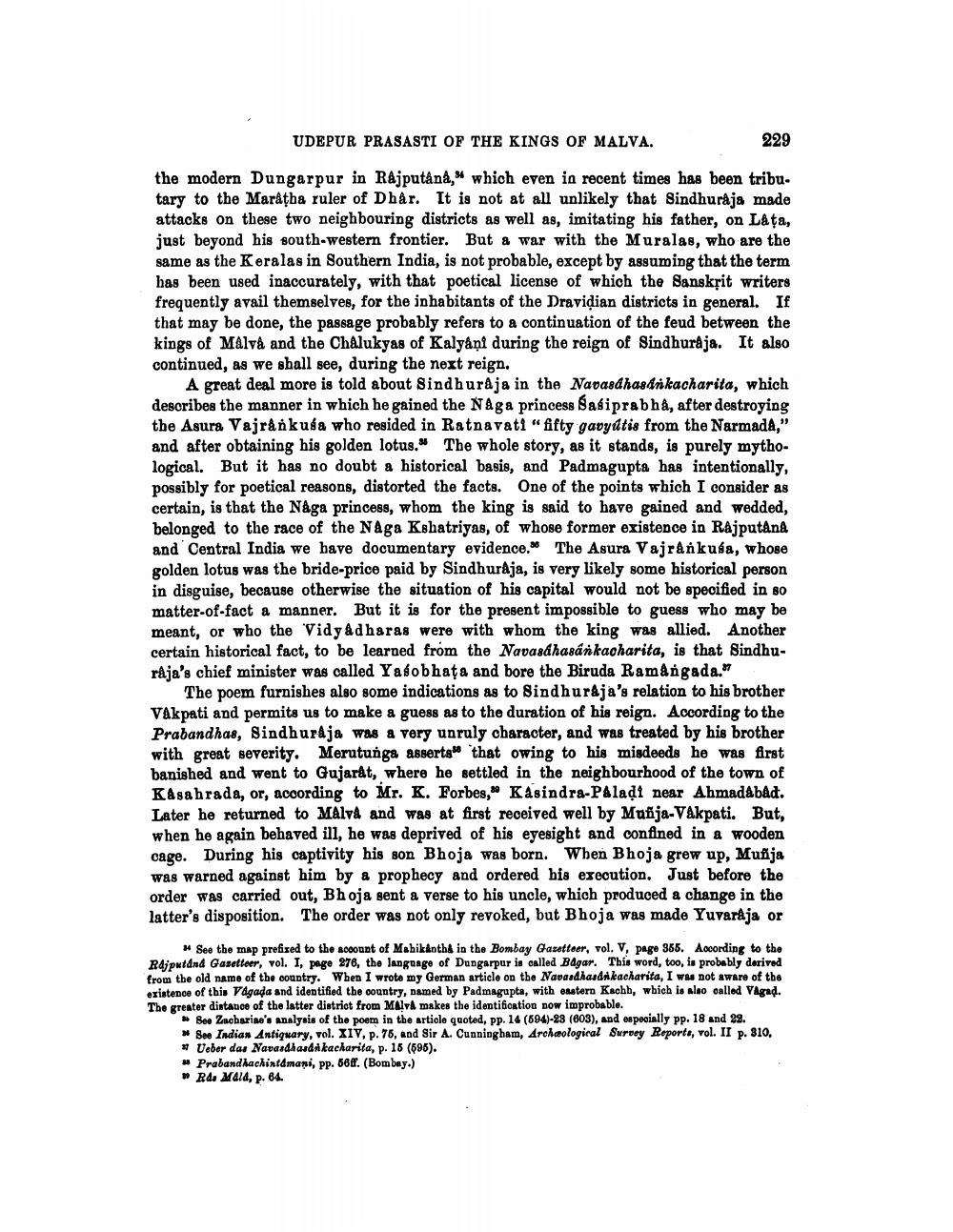________________
UDEPUR PRASASTI OF THE KINGS OF MALVA.
229
the modern Dungarpur in Rajputånd, which even in recent times has been tribu. tary to the Maratha ruler of Dhår. It is not at all unlikely that Sindhuraja made attacks on these two neighbouring districts as well as, imitating his father, on Laţa, just beyond his south-western frontier. But a war with the Muralas, who are the same as the Keralas in Southern India, is not probable, except by assuming that the term has been used inaccurately, with that poetical license of which the Sansksit writers frequently avail themselves, for the inhabitants of the Dravidian districts in general. If that may be done, the passage probably refers to a continuation of the feud between the kings of Malva and the Chalukyas of Kalyani during the reign of Sindhuraja. It also continued, as we shall see, during the next reign.
A great deal more is told about Sindhuraja in the Nadasdhasdrkacharita, which describes the manner in which he gained the Naga princess Sasiprabhå, after destroying the Asura Vajrånkusa who resided in Ratnavati "fifty gavyútis from the Narmada," and after obtaining his golden lotus. The whole story, as it stands, is purely mythological. But it has no doubt a historical basis, and Padmagupta has intentionally, possibly for poetical reasons, distorted the facts. One of the points which I consider as certain, is that the Någa princess, whom the king is said to have gained and wedded, belonged to the race of the Naga Kshatriyas, of whose former existence in Rajputana and Central India we have documentary evidence. The Asura Vajrankula, whose golden lotus was the bride-price paid by Sindhuraja, is very likely some historical person in disguise, because otherwise the situation of his capital would not be specified in so matter-of-fact a manner. But it is for the present impossible to guess who may be meant, or who the 'Vidyadharas were with whom the king was allied. Another certain historical fact, to be learned from the Navardhasánkacharita, is that Sindhuraja's chief minister was called Yafobhata and bore the Biruda Ramangada."
The poem furnishes also some indications as to Sindhuraja's relation to his brother VAkpati and permits us to make a guess as to the duration of his reign. According to the Prabandhas, Sindhuraja was a very unruly character, and was treated by his brother with great severity. Merutunga asserta 'that owing to his misdeeds he was first banished and went to Gujarat, where he settled in the neighbourhood of the town of Kasahrada, or, acoording to Mr. K. Forbes, o Kasindra-Paladi near Ahmadabad. Later he returned to Malva and was at first received well by Muñja-Vakpati. But, when he again behaved ill, he was deprived of his eyesight and confined in a wooden cage. During his captivity his son Bhoja was born. When Bhoja grew up, Muñja was warned against him by a prophecy and ordered his execution. Just before the order was carried out, Bh oja sent a verse to his uncle, which produced a change in the latter's disposition. The order was not only revoked, but Bhoja was made Yuvardja or
* See the map prefixed to the account of Mahikanth in the Bombay Gazetteer, vol. V, Page 856. According to the Rdiputand Gasetteer, vol. I, page 876, the language of Dungarpur is called Bdgar. This word, too, is probably derived from the old name of the country. When I wrote my German article on the Navardhandikacharita, I was not aware of the existence of this Vagada and identified the country, named by Padmagupta, with opatern Kachb, which is also called Vagad. The greater distance of the latter distriot from Malvå makes the identifoation Dow improbable.
>> Boo Zacharias's analysis of the poem in the article quoted, pp. 14 (694)-28 (003), and especially pp. 18 and 22. ► See Indian Antiquary, vol. XIV, p. 76, and Sir A. Cunningham, Archeological Survey Reports, vol. II p. 310, * Veber das Navasdhardikacharita, p. 15 (595). # Prabandhachintamani, pp. 568. (Bombay.)
Rd. vald, p. 64.




